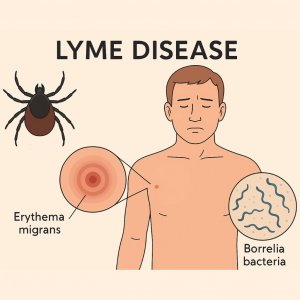Fun fact
Lyme disease is named after Lyme, Connecticut, the town where it was first identified and definitely not after limes the fruit!
Cause & Spread
Lyme disease is caused by a spiral-shaped bacterium (Borrelia burgdorferi, and a related species B. mayonii) that ticks carry. You get Lyme through the bite of an infected blacklegged tick (also known as the deer tick). These ticks are tiny (often no bigger than a poppy seed) so they can bite you without you even noticing. In the U.S., blacklegged ticks that spread Lyme are mostly found in certain regions (see “Regions” below). The tick usually needs to be attached for over 24 hours to transmit Lyme bacteria, so finding and removing ticks quickly can prevent infection. (Quick tick checks for the win!)
Regions at Risk
Lyme disease is most common in the Northeastern, Mid-Atlantic, and north-central (Upper Midwest) states. States like Connecticut, Massachusetts, New York, New Jersey, Pennsylvania, Wisconsin, and Minnesota see a lot of Lyme cases. There are also smaller pockets on the West Coast (northern California, Oregon) where the western blacklegged tick spreads Lyme. If you live or hike in New England or the Great Lakes region, for example, Lyme is a big concern. In contrast, blacklegged ticks in much of the Southeast U.S. are almost never infected with Lyme bacteria, so the disease is less common in southern states.
Symptoms
Lyme disease often (but not always) starts with a distinctive skin rash called erythema migrans (EM). About 70–80% of people with Lyme get this rash. It usually appears 3–30 days after the tick bite (about a week on average). The rash often begins at the bite site and expands over a few days, sometimes clearing in the center to look like a bull’s-eye target. It’s usually not painful, though it may feel warm.
Important: Not all Lyme rashes look like a perfect bull’s-eye – they can be uniformly red or other shapes, and some people don’t get a rash at all. Along with (or instead of) the rash, early Lyme symptoms are usually flu-like: fever, chills, headache, fatigue (feeling really tired), muscle and joint aches, and swollen lymph nodes.
If untreated, the infection can spread and cause more serious problems weeks to months later. These late-stage symptoms can include severe headaches and neck stiffness (from meningitis; inflammation of brain/spinal cord coverings), facial palsy (one side of the face droops; Lyme can cause a temporary facial paralysis called Bell’s palsy), pain or numbness in hands/feet, heart rhythm problems (Lyme carditis, which can cause dizziness or chest pain), and arthritis (especially swelling and pain in the knees).
The good news is that Lyme disease is treatable, especially if caught early.
Diagnosis
If you’ve been in tick country and develop symptoms like a rash or fever, see a doctor. Lyme is usually diagnosed based on symptoms (like the EM rash) and likelihood of exposure to ticks. Blood tests can help confirm Lyme, but they may not turn positive until a few weeks into the infection, because they look for your immune response to the bacteria.
Doctors often do a two-step blood test:
- an ELISA screening test, and if that’s positive,
- a Western blot test to confirm.
If you have the rash, many doctors will diagnose Lyme on the spot (the rash is pretty specific to Lyme) and start treatment without waiting for tests.
Treatment
Antibiotics are used to treat Lyme disease. The sooner you get treated, the better. Most uncomplicated cases can be cured with a course of oral antibiotics for 10–14 days. A common antibiotic for Lyme is doxycycline (for adults and kids over 8), or amoxicillin/cefuroxime for younger children and pregnant women. Early treatment usually leads to a rapid and complete recovery. Often people start feeling better after a few days of pills.
Important: It’s important to finish all the medicine even if you feel okay, to make sure the bacteria are really gone.
In more serious cases (like Lyme that affects the heart or nervous system), IV antibiotics might be needed.
There’s no vaccine for Lyme available for people right now, so prevention (avoiding tick bites) is super important.
Bottom line: If you treat Lyme early, you’ll most likely be just fine.
Many people fully recover, especially when treated right away. Some people have lingering symptoms (like fatigue or aches) after treatment (a condition sometimes called “Lyme disease syndrome”) but ongoing research is trying to understand and help with that.

